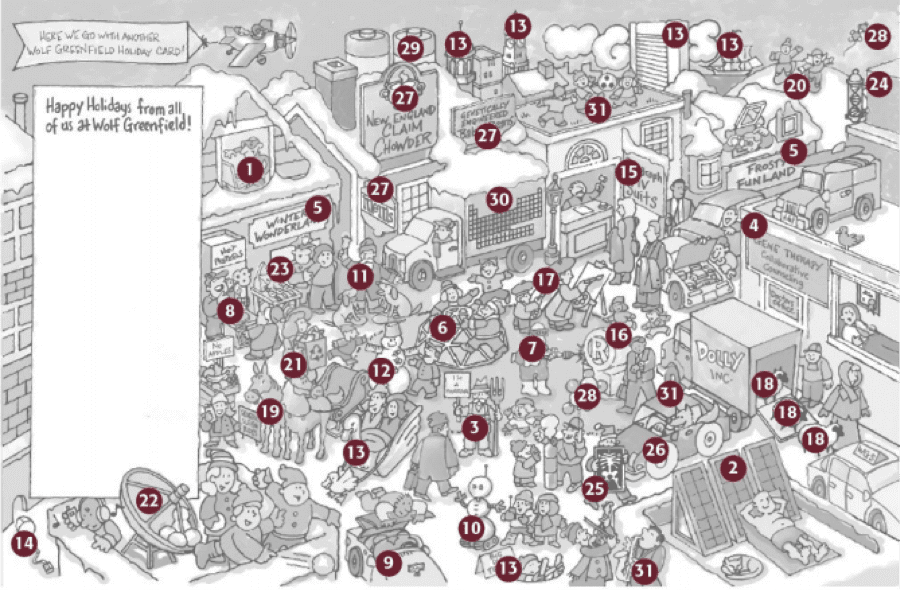Law Firm Holiday Cards – Do’s and Don’ts
Q: Are holiday cards effective?
A: I think that they can be considered one more nice way to stay in touch, to send a friendly communication to a large number of clients and prospects all at once. Of course, I said that they can be effective, not that they typically are.
Holiday cards pose complex issues of database management and client ownership, combined with the logistical questions of who signs which card(s). Only through hard work and discipline are these issues mightily overcome. Only to become one of a dozen bland, look-alike cards depicting politically correct images like pine trees, ice skaters, snow-covered skylines, ambiguously decorated snow men, or handicapped children’s artwork — which are then sent to dead former clients. All in the name of strengthening client relationships?
Done well, the cards should reinforce your firm’s unique brand message, or at least stand out somehow, so they don’t get immediately discarded and forgotten. When I was the marketing partner of a law firm, it wasn’t unusual for me to get as many as 25 generic holiday cards per day from vendors all wanting our business.
Glance, toss, forget.
Glance, toss, forget.
Glance, toss, forget.
It helps if you have a strong brand message, or at least an interesting look. For example, last year, for “Small but Mighty sm” Novack and Macey (a terrific litigation boutique whose message is that they’re disproportionately powerful for their size, see www.novackmacey.com), we sent a card showing a small, festively decorated red box and a “Good things come in small packages” headline.

Sally Crocker’s annual mailers at Wolf Greenfield are always interesting – a very targeted message connecting creativity to IP (see http://tinyurl.com/26nqpml), below:
The point is — the card represents your entire firm and practice.
Don’t rub clients’ noses in your firm’s lack of creativity by doing the same thing as everyone else. Find some way to do something different.
And if your lawyers can’t make the time to sign the cards personally, don’t send them. Nothing says “I care about you and deeply value your business and our relationship” like a generic, unsigned card with the firm’s name foil-stamped on them. You ever get one of those from your accountant? Don’t they make you feel all warm and fuzzy inside?
I always get that special feeling, knowing that he took the time out of his busy schedule to have his secretary include me on the same mass-mailed list as hundreds or thousands of clients and prospects. Oh, if he’d only send me a pleather calendar with his firm’s name embossed on it, then I’d know for certain that he’s going to do his very best for me in 2011.
Email versions of holiday cards are gaining in popularity because they allow more creative freedom, with Flash animations of holiday-themed items zooming and spinning and morphing needlessly into each other. The high-minded explanation is that they’re green and save paper. Internally, they’re thinking that no one has to sign anything if it’s sent via email. It’s easy.
Because you can effortlessly send them from a simple database to tens of thousands of recipients with the click of a button, they are arguably even less personal than unsigned paper cards where someone, somewhere, at least had to lick a stamp. Those that avoid the spam filters don’t generate much goodwill. On rare occasion, terrific creative work might cause one to stand above the pack and get a notice or a smile. Kelly Kiernan Largey, CMO at Fish & Richardson, always does fun fish-themed holiday cards; see the short film at www.fr.com/holiday2009/.) Screen shot:
However, most get the typical treatment – Glance, Shrug, <Delete>.
I always get a holiday card from my best friend, a terrific lawyer I’ve known for 30 years. We shared our first beer together. He was the best man at my wedding. He held my first son within minutes of his being born. I refer him lots of business. The card, his 15th consecutive snowy Chicago skyline, wishes me “Happy Holidays from [his law firm],” signed with a badly pixilated low-res scan of his signature, “John.” (Not his real name.) No note. I’m going to have to talk to him about this. Again.
I know he’s really busy but, frankly, I think those types of mailings do more harm than good.
Few people have ever said, “My lawyer didn’t wish me a generic “Seasons Greetings” this year; I’m taking my business elsewhere!” That is, if you’re going to do it badly, just don’t do it; no one will notice its absence.
But if you can find, that is, make, the time, a personal, handwritten note is incredibly powerful. In our instant era of type-and-click email, 140-character tweets, and Facebook pokes, a personal snail-mail note with a handwritten address creates a big impact. Today I might get 100 emails and 25 generic holiday cards that I’ll forget by tomorrow, but a decade later, I still have the handwritten, 15-word “Congratulations, Ross!” note written in thick, blue, felt-tip marker from one of the nation’s best lawyers and nicest guys, Mike Coffield.
Even though I know he dashed off at least 25 short cards each week in a stack organized by his secretary, it still feels special to receive one. It’s the difference between sincerely caring about people and doing the least amount necessary because you’re “supposed” to send cards. The recipients can tell the difference. It’s quality, not quantity.
Finally, while I know this whole rant is making me sound like Scrooge, I’ve never been a big fan of cards that promise “In lieu of a personal gift to you, we’re making a donation in your name to the following charity(ies).” In my actual name? Does that mean I get a tax deduction on that money? Did they ask me whether I’d prefer receiving the gift? Or at least help select the charity? And because they never tell you how much they’re donating; everyone I’ve quizzed about this assumes that they’ve taken this approach because it was cheaper and easier. And generally, from my experience, they’re right.
At least that’s how I see it.
Season’s greetings,
Ross



